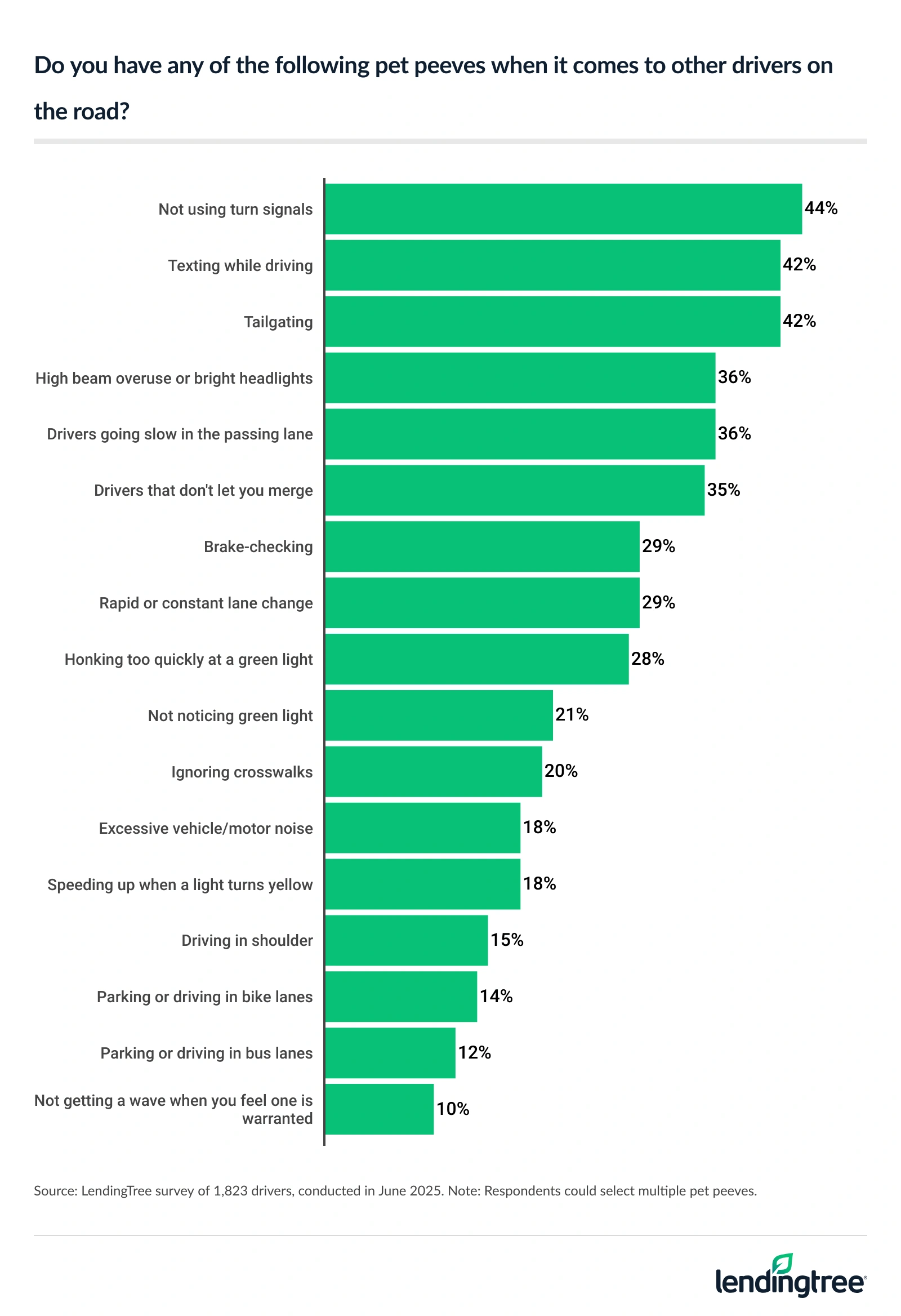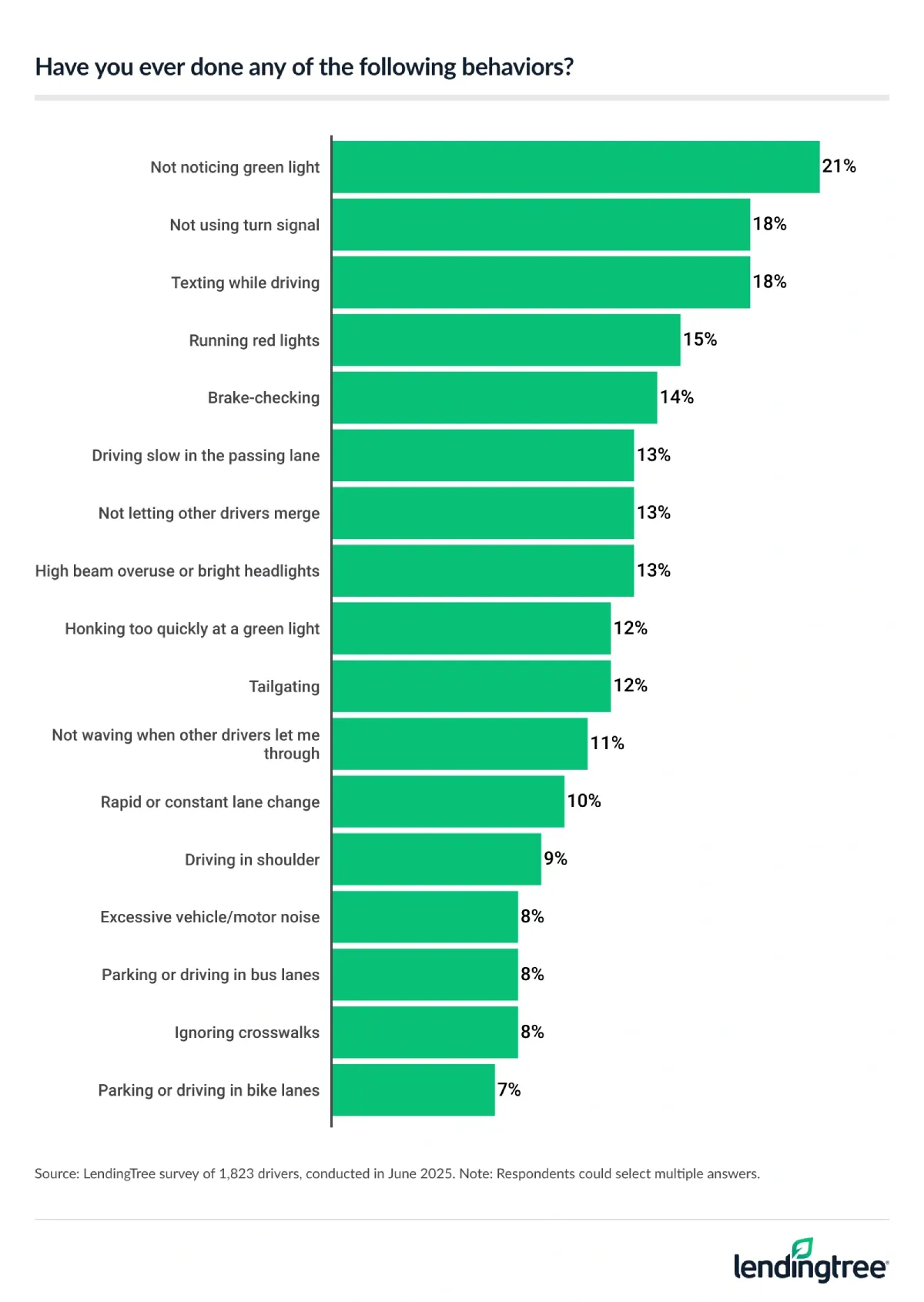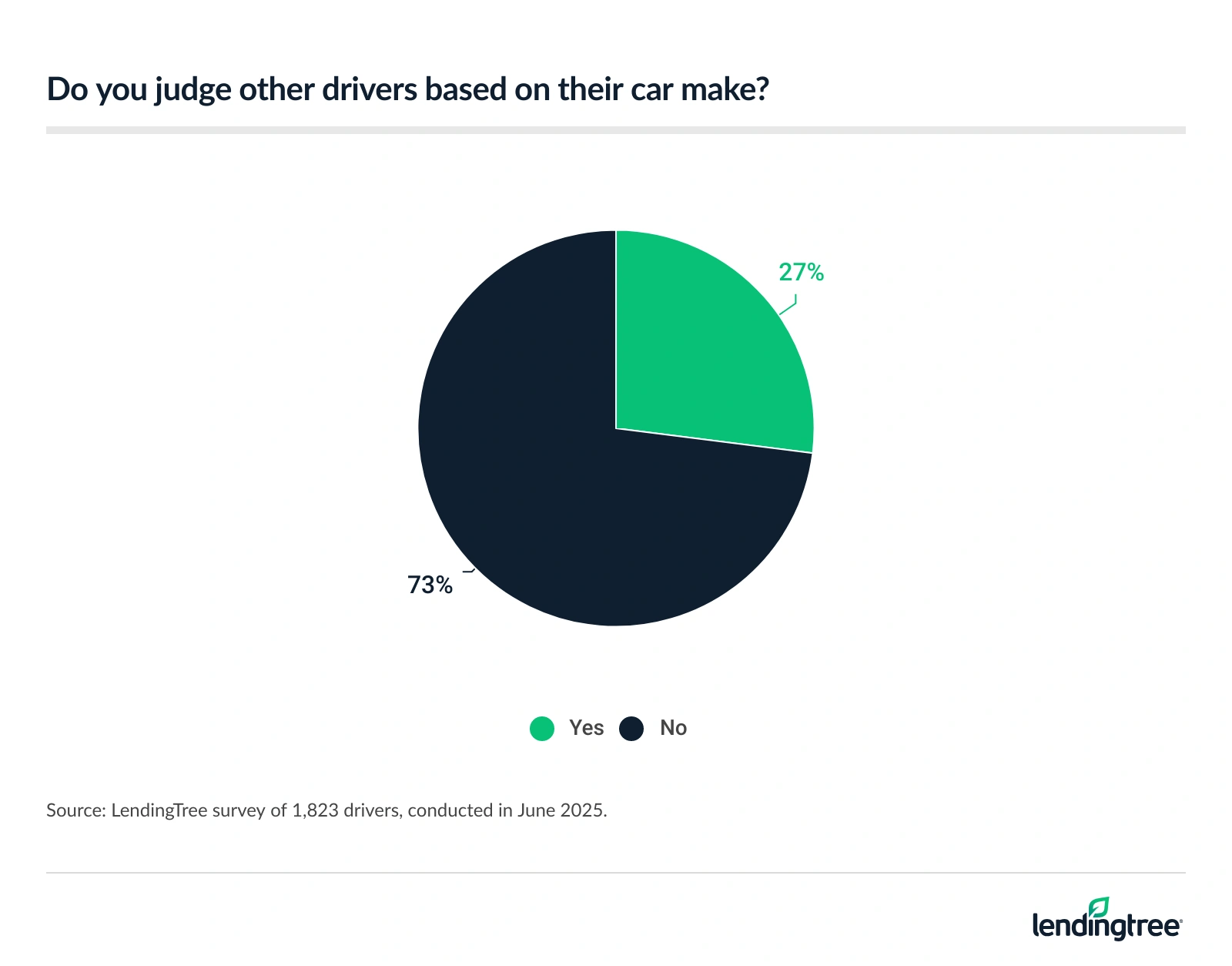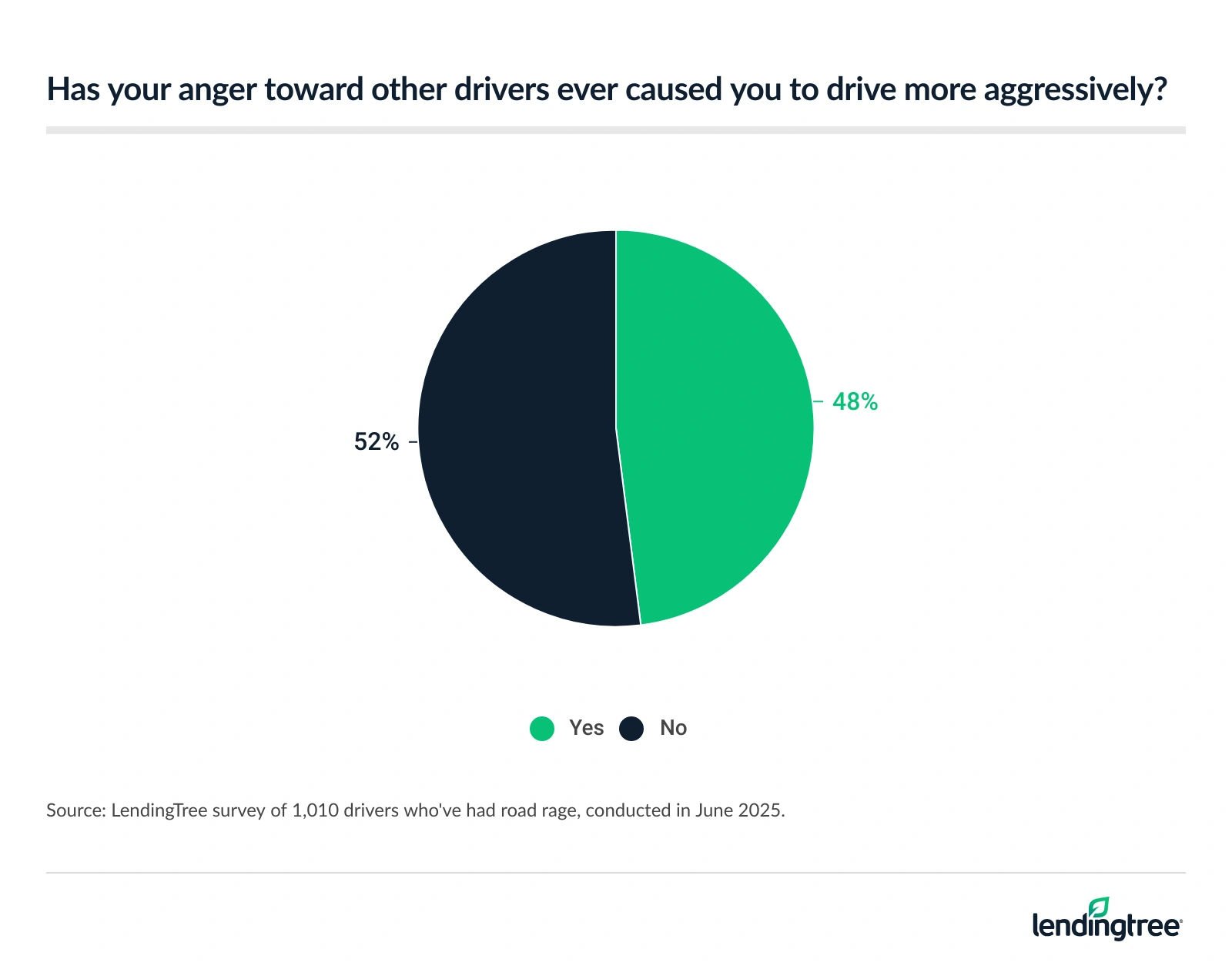92% of Drivers Have Pet Peeves, but Fewer Admit to Committing Them
Driving may get you where you need to go, but it can also test your patience like nothing else.
According to a LendingTree survey of 2,050 U.S. consumers, 92% of drivers have a pet peeve on the road, but only 76% admit they’ve been guilty of committing one while driving.
Here’s a closer look.
Key findings
- Nearly all drivers admit to having at least one pet peeve that grinds their gears. Among the 92% of drivers with a pet peeve, not using a turn signal tops the list (44% of drivers). The next most common pet peeves are texting while driving (42%), tailgating (42%) and overusing high beams (36%).
- Fewer drivers admit they’re part of the problem. 24% say they’ve never committed any of the listed pet peeves. Of those who have, the most common offenses include not noticing a green light (21% of drivers), not using a turn signal (18%) and texting while driving (18%).
- Many are cautious of certain vehicle types. Over three-quarters (77%) of drivers say certain vehicle types make them more wary of a driver’s behavior. In particular, motorcycles (41%), sports cars (28%) and pickups (27%) cause drivers to be more watchful. Moreover, 27% say they judge other drivers based on their car make.
- Over half of drivers confess they’ve had road rage. While 26% of Americans claim they get easily angered while driving, 55% of drivers say they’ve had road rage. Gen Z (66%) and millennial (63%) drivers are the age groups most inclined toward anger behind the wheel.
- Road rage doesn’t stay in one lane. Among drivers who’ve had road rage, nearly half (48%) admit that anger has caused them to drive more aggressively. Men are significantly more likely to say so than women (57% versus 37%). Additionally, half (50%) of drivers say they’ve used obscene language or hand gestures toward other drivers, while 57% have used their horn to “scold” other drivers.
Most drivers have pet peeves
Among drivers, 92% have a road-related pet peeve, and 44% say not using a turn signal is one of theirs — the most common response. Texting while driving (42%) and tailgating (42%) are also common pet peeves.

LendingTree car insurance expert and licensed insurance agent Rob Bhatt says these behaviors can be as dangerous as they are annoying. “Texting while driving is particularly dangerous,” he says. “It takes your eyes off the road, a hand off your steering wheel and your attention off potential hazards that can arise when you least expect it.”
But there’s more to considering other drivers than putting down your phone, Bhatt says. “Tailgating increases your chances of rear-ending a driver,” he says. “And overusing your high beams is also a hazard to other drivers. It diminishes their visibility.”
When it comes to the iffy behaviors drivers notice the most, not using turn signals (43%) again tops the list. Tailgating (39%) and drivers that don’t let you merge (32%) follow.
Meanwhile, drivers are more likely to say that people driving too slow (46%) is more annoying than people driving too fast (37%).
Nearly a quarter think they’ve never committed a pet peeve
While the majority are critical of other drivers on the road, they’re less likely to find faults with themselves. In fact, nearly a quarter (24%) of drivers say they’ve never committed any of the listed pet peeves — a claim that’s most common among those earning less than $30,000 (32%), baby boomers ages 61 to 79 (30%), women (30%) and those without children (29%).

Among drivers, 21% say they’ve failed to notice a green light — the most common behavior. Meanwhile, 18% didn’t use a turn signal and 18% admit to texting while driving.
Vehicle types and brands have bad reputations
It may be unfair, but stereotyping is real. Over three-quarters (77%) of drivers say certain vehicle types make them more cautious of a driver’s behavior.
Across drivers, 41% say they’re more watchful around motorcycles — the most common response. Sports cars (28%) and pickups (27%) are close behind, ahead of:
- SUVs (16%)
- Electric vehicles, or EVs (14%)
- Sedans (11%)
- Minivans (10%)
Also worth noting, 27% say they judge other drivers based on their car make.

Drivers think Tesla (19%) and BMW (18%) drivers tend to be the worst. And there may be some truth to that: According to a LendingTree study on the worst drivers by vehicle brand, Tesla drivers had the highest incident rates (which included accidents, DUIs, speeding and citations), while BMW drivers were among those with the highest DUI rates.
Bhatt says it’s important to be aware of all the vehicles around you. “You need to pay continuous attention to the traffic in front of you and also regularly check your mirrors for any hazards approaching from behind,” he says. “If a certain vehicle is making you nervous, give it space.”
Some think they need to exercise more patience than other drivers in the U.S., as 46% believe that drivers in their area are worse than those in other comparable cities or towns. That rises to 56% among Gen Zers ages 18 to 28 and those with children younger than 18.
More than half of drivers have had road rage
Anger behind the wheel is unfortunately common, with 55% of drivers admitting they’ve had road rage. That figure rises to 66% among Gen Z drivers and 63% among millennial drivers ages 29 to 44.
“A near miss in traffic can trigger an emotional response,” Bhatt says. And he also thinks the age breakdown makes sense: “Older people tend to be able to control their emotions better than younger people,” he goes on. (To his point, only 38% of baby boomers say they’ve experienced road rage.)
Additionally, men (59%) are more likely than women (52%) to experience road rage — which Bhatt says could be biological.
“The biological makeup of young men probably makes it harder for them to control their aggression than young women,” he says. “Uncontrolled testosterone and runaway adrenaline form a dangerous combination.”
Road rage can be reckless
Concerningly, nearly half (48%) of drivers who’ve had road rage admit that anger has caused them to drive more aggressively.

Men are significantly more likely to say so than women, at 57% versus 37%.
Regardless of whether they’ve had road rage, 50% of drivers say they’ve used obscene language or hand gestures toward other drivers. That percentage rises for those with children younger than 18 (60%). Another 57% have used their horn to “scold” other drivers.
Managing road rage: Top expert tips
If you’re prone to road rage yourself — or want to be prepared for a potential encounter with an aggressive driver — there are a few things you can do to deescalate the situation. We recommend the following:
- Patience is a virtue — and a necessity. “People are human,” Bhatt says. “We all make mistakes. Cut your fellow drivers a little slack. No transgression behind the wheel is worth the risk of serious injury or death.”
- Avoid escalating tense situations. Yelling or gesturing at another driver usually causes more problems than it solves.
- Have an exit plan. If another driver starts acting aggressively toward you, start driving to a safe place, like a police station or well-lit business establishment with a lot of people around.
People are human. We all make mistakes. Cut your fellow drivers a little slack. No transgression behind the wheel is worth the risk of serious injury or death.
Methodology
LendingTree commissioned QuestionPro to conduct an online survey of 2,050 U.S. consumers ages 18 to 79 from June 12 to 14, 2025. The survey was administered using a nonprobability-based sample, and quotas were used to ensure the sample base represented the overall population. Researchers reviewed all responses for quality control.
We defined generations as the following ages in 2025:
- Generation Z: 18 to 28
- Millennial: 29 to 44
- Generation X: 45 to 60
- Baby boomer: 61 to 79


